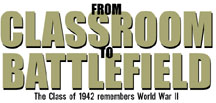
As
the Princeton Class of 1942 gathered in Alexander Hall for
its initial orientation meeting, the media were reporting
international tensions of increasingly grave concern. As senior
year began, the situation had not improved substantially.
The death of classmate Bud Wade in the sinking of the Reuben
James on October 31, 1941, brought the war close to home,
but campus life went on with no discernible changes for the
next five weeks.
With Pearl Harbor
came the virtual certainty that those who were physically
able would be called to service. By commencement time approximately
40 percent of the members of the class had entered into reserve
programs leading either to commissions on graduation or to
officer training. Others volunteered for induction or were
called in the draft. Of those who began their senior year,
17 were allowed to accelerate their graduation and 32 received
War Certificates as evidence of withdrawal in good standing
to enter the service. The great majority, however, remained
until graduation - but on borrowed time.
Approximately five-sixths
of the class served in some capacity, from Adak to Auckland,
from Bastogne to Bougainville, from Casablanca to Chungking,
from Oran to Okinawa. Some were exposed to grave danger while
others had important posts in which they were not close to
combat. Twenty-five classmates gave their lives. Many others
were wounded. Two classmates received the service's second
highest decoration (Distinguished Service Cross; Navy Cross).
There were quite a few Silver Stars and even more Bronze Star
Medals, along with many Purple Hearts. Seven classmates became
prisoners of war.
The following are
excerpts from just a few of their remarkable stories.
Henry S. Austin,
Jr.
Henry S. Austin,
Jr. spent more than three years in the Navy as a pilot, serving
on the aircraft carriers USS Hancock and USS Ticonderoga and
receiving the Distinguished Flying Cross and two Air Medals.
On January 21, 1945, the Ticonderoga was attacked.
This fateful day
will never die in the memories of a gallant ship's crew and
marks the beginning of the last chapter of this log of the
cruise on the "Big T." After early noon chow, I
repaired to the ready room to prepare for the hop. At about
12:45, without any warning, every A.A. battery of every ship
in the fleet opened up. As most of us rushed out to see what
it was all about, GQ sounded so most of us returned to our
stations in the ready room. About one full minute after it
happened it was over. The ready room gave a quick compulsive
heave and the firing stopped as quickly as it had begun. We
all knew that something we had become firmly convinced would
never happen had just happened: the "Big T" had
been hit.
As we later learned,
three kamikazes had attacked us at once. Why there was no
warning from the radar we didn't yet know, but the ship never
got to GQ before we were hit, and, as a result, the damage
had more far-reaching effects than would otherwise have been
the case. . . . The immediate destruction from this explosion
was terrific. Men were working on the aircraft on the hangar
deck and were burned to death immediately.
Taken completely
by surprise, the men available after the explosion did a job
nothing short of miraculous in controlling and eventually
extinguishing the fires on both decks. Barely recovering from
the effects of this first blow, we fought off two more attempts
to hit us, and then, only 40 minutes after the first, a second
one got us, forward and high on the island. . . . it was here
that Commander Miller was killed. The executive, Commander
Burch, had his foot badly shot up, but suffered no other major
injuries. The captain had his right arm smashed and his neck
badly cut. He lay on the deck refusing aid until the cases
requiring immediate attention were taken care of. He was unable
to take visual control of his ship, but kept well informed
of the developments and remained on the bridge until he lost
strength and was forcefully removed by the doctors. . . .
The dead were buried at sea the following day. The ceremony
took a long time. There were many dead, I believe about 150.
Gordon Bent
Gordon Bent was
commissioned as a second lieutenant of field artillery at
the ROTC ceremony during 1942 commencement. After volunteering
for combat duty, he served in Africa and Italy, earned a Silver
Star, and was separated as a captain in November 1945. One
of his most memorable moments came near the end of the war.
One of the significant
prizes of victory that came to us was the surrender of Reichsmarschall
Hermann Goering. Since Hitler's suicide, he was the titular
head of Germany and its defeated army. . . . At the time,
Goering was among the missing and was assumed to be hiding
in the alpine foothills, which he was. Two days after the
official VE-Day, a smartly dressed German major came into
the 36th Division area, which adjoined our headquarters in
Kufstein. The major announced that he was Goering's aide-de-camp
and was prepared to offer his commander's unconditional surrender.
Although unexpected, the offer was accepted with alacrity.
A friend, Chuck
Herbison, received orders to fly his aircraft to the division
field, and I eagerly joined him to receive this major surrender
coup. Goering . . . was fat and round as advertised, with
a large cherubic face to match. Although without medals for
once, he wore a field marshal's uniform and a pistol on his
belt.
The 36th Division
commander had ordered us to fly our plane to his field because
we had the only L-5 airplane around and they figured the smaller
L-4 couldn't lift "Hermann the German." When he
climbed in, he said, "heiss," meaning "hot,"
as our cockpit had been sitting in the sun all day. It was
the first I knew that he didn't speak English, as did most
of his fellow officers . . .
At the last moment,
Chuck was replaced as pilot of his own plane, outranked by
the divisional pilot who sought the glory. They were about
to taxi away when we remembered Goering's pistol, his reputation
as a flyer, and that Switzerland was not far away. It was
removed. By me! For a brief moment, I had in my hands a finely
polished holster that without doubt contained a Luger. This
was not only my long-sought souvenir, but perhaps an exquisitely
inlaid model. A major tapped me and I passed it on, as he
did very shortly to a lieutenant colonel. With so much rank
around, it no doubt ended up with the two-star general in
attendance, leaving a chagrined chain behind.
John D. "Tex"
Farrington, Jr.
John D. "Tex"
Farrington, Jr. was an Army officer stationed in Luzon, Philippines,
when the atomic bomb was dropped on Japan. Farrington and
two other officers were ordered to southern Honshu, the largest
Japanese island, to lay the ground for the American occupation.
Two other officers
and I were ordered to report to a Navy command ship in Zamboanga,
Mindanao. We were put on a little DE (destroyer escort) and
headed for Okinawa to pick up special thermite grenades. We
were to precede the occupation of southern Honshu by 10 days
and insure that there weren't any nasty surprises waiting
for our troops.
We finally entered
the Hiro-Wan, a Honshu bay, preceded only by a mine sweeper
that was having a lovely time popping off dozens of mines.
After a rather weird surrender ceremony, I headed up a mountain
on foot. A typhoon had totaled the mountain roads. With me
was a Nisei interpreter and a Japanese naval lieutenant. We
walked through the town of Hiro, where its mayor and a delegation
surrendered the town - an eerie experience - giving me their
flag, which I still have. At the top of the mountain, up about
2,000 feet, was a complete installation of six 5-inch guns
ready for battle, in violation of surrender terms. Quaking
in my boots, I convinced them that they would be attacked
by sundown if they didn't stand down, which to my vast relief
they did. There were no further violations. When we finished
our assignments, we three commandeered a Japanese charcoal-burning
truck and drove to Hiroshima, possibly the first westerners
there since the bomb was dropped. It was a ghastly scene that
can't be given justice here. Later, I flew around Nagasaki
for over an hour. The horrors of an atomic war are indescribable.
Later, we were
able to sit on a hillside and watch the vast American armada
assemble and come so efficiently ashore and occupy a foreign
country, a rare privilege to watch an unforgettable scene.
Upon return to
Luzon, I was appointed commander of Prisoner of War Camp #21,
to contain 3,000 of General Yamashita's diehards. I was given
one sergeant, four corporals, and 110 GIs. It was like establishing
a small city: buildings, tents, sewerage, electricity. And
it was the most fulfilling job I ever had.
I tried to run
the camp based on the principles of the Four Freedoms. There
was freedom of the press in a camp newspaper, occasionally
read to me. Freedom of religion through chaplains invited
to the camp. But, most important, we had freedom of speech,
as long as it didn't get out of control. This was a revelation
to the Japanese! Each Sunday, my desk was moved out to the
parade ground, and I was available to openly discuss any subject
and, in return, to ask them about their beliefs. At first,
there were only a few attendees, but after a few weeks, up
to a thousand came, and were well prepared. It was quite a
challenge and a defining event that I recall with pride.
William C. Orr
Before William
C. Orr joined the Navy in late 1944, he played a scholarly
role in one of the greatest secrets of the war - so secret
that he didn't even know his own involvement.
In the final months
of our senior year, Professor Hugh S. Taylor, himself involved
in research for the Manhattan Project, urged chemistry majors
to pursue graduate study in areas where he knew there was
a shortage of trained personnel. In my case, he suggested
Berkeley, where the field of nuclear chemistry had begun to
emerge as a consequence of the needs and the opportunities
created by the development of E. O. Lawrence's cyclotron.
When I had been
working at the University of California for little more than
a year, an urgent appeal was made to six or eight graduate
students who, like me, had become familiar with the techniques
of handling radioactive materials and performing chemical
operations on them. For two or three weeks, our help was needed
to carry out some sort of round-the-clock chemical procedure
that began with the dissolving of chunks of heavy metal in
acid. We were told that the metal had been bombarded in a
cyclotron and was therefore highly radioactive, to be kept
behind a thick lead barrier at all times. We were not told
what exactly we were dealing with or what was to be accomplished.
Our instructions were spelled out in terms such as "add
solution A until a yellow solid precipitates; filter out the
solid and dissolve it in solution B." Solutions A, B,
C, etc., were provided to us without further identification.
About all that I or the others could deduce was that we were
extracting something from the original material and concentrating
it to a considerable degree in the course of our work.
At sea, some three
years later, I was reading about the work of [scientists]
in the Manhattan Project who were studying the chemistry of
a new element, plutonium, artificially produced in trace amounts
by the bombardment of uranium in the cyclotron. They could
observe these trace amounts only because of plutonium's radioactivity,
and they badly needed larger quantities - at least enough
to see! - if they were to confirm the feasibility of the scheme
for separating plutonium from uranium that they were attempting
to develop for use on an industrial scale. To produce more
of this artificial element, slugs of uranium were bombarded
almost continuously for six months in three different university
cyclotrons. The slugs were then collected at Berkeley and
became the starting material for the process in which I had
participated. Quite without knowing it at the time, I now
realized that I had been helping to prepare the first visible
sample of plutonium ever to exist.
Edgar D. Romig
Edgar D. Romig
joined the American Field Service, which provided ambulances
and drivers to the Allies, during his senior year and with
classmate John Harmon was sent to Egypt, where they worked
to rescue soldiers during the battles of El Alamein and Mareth.
Later, Romig joined the Army and spent the winter of 1944--45
in France. He earned a Bronze Star and Purple Heart, among
other awards.
My memory fails
me a little, but I know we reached Rouen in France in the
autumn of 1944 and were in Alsace near Hagenau that Christmas.
It was cold and dark, and I felt sorry for the lady and her
young son whose barn we were sleeping in. Their village had
suffered terribly. On the evening of January 15, 1945, there
was an important announcement for us. Our captain gathered
us together and told us we would be awakened an hour before
dawn for an attack. We would be given white sheets for camouflage
since there was snow on the ground. The platoons would move
forward in parallel columns through a woods. Beyond the woods
was an open field stretching perhaps 300 or 400 feet before
reaching a second woods, in which there was one machine gun
to be knocked out.
We reached the
first woods on schedule. But as dawn approached, something
went wrong. We heard American conversation though silence
had been ordered. The strange conversation continued for just
a few seconds, but enough to alert the enemy. Then someone
shouted "Charge" and "Attack." Our squad
followed orders and ran forward from the woods where we had
been waiting, towards the woods beyond the field and towards
what were several machine guns, not just one. I was hit in
my left tibia by a machine-gun bullet about halfway towards
the second woods. I moved to the rear on my back to a declivity
at the edge of the woods from which we had started. There
were two or three other wounded men nearby. I read Psalm 23
out loud with their approval.
About 3:00 p.m.,
as the January shadows began to lengthen, I heard a German
voice say "Er ist tot" ("he is dead").
This convinced me that our attack had failed and that I had
better try to move. Using my right leg and both elbows, I
did succeed in getting through the woods on my back, despite
some cuts and bruises, but was not quite sure whether I was
going in the right direction. As I continued beyond the woods
(west of the woods from which we had started), machine-gun
fire and artillery fire continued. Then a brave Dartmouth
College medic saw me, rushed to me, and helped me back to
safety. A tank took me to a tent hospital where the bullet
was taken out. A week or two later, I had a second operation
in Paris. They flew me home, with hot chocolate served by
English Grey Ladies at a stop in Bermuda in early March.
Two weeks after
graduating from Princeton, Prentice K. Smith - along with
three classmates, Elliot Pogue, Dick Boenning, and Bob Marquardt,
all of whom transferred to tank destroyers and served with
distinction - headed to Fort Bragg as a commissioned Army
officer. He fought in the invasion of Sicily, landed on Omaha
Beach on D-Day, and made his way through France, Belgium,
and the Battle of the Bulge before finishing out the war in
Czechoslovakia. He earned three Silver Stars, a Bronze Star,
and a Purple Heart.
The Sicilian campaign
ended and we boarded transports and set sail. The hot rumor
was that we were going to the States, but instead we made
a wide sweep into the Atlantic and landed on the southwest
coast of England. We spent a wonderful winter in Dorset, not
knowing it was to be our staging area for D-Day. By May 1944,
it became apparent that the invasion would be starting soon.
When we finally got briefed, I learned I was to be in the
second wave of the landing at Omaha Beach.
The embarkation
and overnight trip across the Channel was an event I will
never forget. I stayed on deck most of the night and watched
the hundreds of troop carriers, planes, and gliders pass overhead.
Before dawn, we climbed down nets to the boats that were to
beach us. In the water and ashore, there were bodies all over
the place, and the wounded were screaming. Abandoned equipment
littered the beach. Small-arms fire was heavy. We ran as fast
as we could to a sea wall and got to a place where the enfilading
fire from the Germans could not hit us. Eventually, a guide
who'd made it to the top of the cliff came down and led us
up a trail that had been cleared of mines. On top, we spent
a sleepless night. I felt completely useless.
The next day, we
made a limited advance. On my map, I saw a building called
Chateau Rouge that looked like it might be a good observation
post. Moving cautiously, my section and I entered the building,
which turned out to be a farmhouse. The family inside was
terrified. I immediately radioed for missions against terrain
I could see. I had the same difficulty as in Sicily pinpointing
my location, but word finally came through: "Help is
on the way." This time, they only sent a platoon. I continued
to target missions for the destroyers and cruisers firing
offshore.
At one point, I
was asked if I could see Ceresy Forest, because they wanted
to fire from a battleship at a suspected ammo dump and tank
concentration there. I said, "Sure," just because
I wanted to hear what a 16-inch battleship shell would sound
like. It came over like an express train. I didn't see it
land. That night, we took turns manning the observation post.
I chose the last shift because I wanted to be alert at dawn.
While I slept, horses and wagons with small units of Germans
passed under our window for an hour, pulling back from the
front. For these events, I received the Bronze Star.
After the break-out,
I was promoted to captain. We crossed the Seine, traveling
through the battlefield made famous by our First Division
in World War I, and finally hit the Belgian border. Life was
dull and artillery ammunition in short supply. But then a
Frenchman informed us there was a German strong point down
the road from us. I went out with a patrol to investigate.
Suddenly, our guide cried out, "Les Boches," and
did a somersault through a hedgerow. All hell broke loose,
everyone firing and German burpguns sounding off. I jumped
over a wooden gate with my radio pack on my back and settled
down behind a stone wall to call for a mission. The reply
came back: "Missions denied." So I repeated my order,
this time making it sound like we had a regiment in front
of us before I got action. None of us were hurt. The Frenchman
came back full of praise and said the Germans had pulled back.
For this act of sheer stupidity, I received my second Silver
Star.
From then on, the
war turned ugly. We took Aachen, then got bogged down in the
Hurtgen Forest, which eventually ended up as the north shoulder
of the Battle of the Bulge. It was worse than D-Day. We finally
crossed the Rhine at Remagen Bridge, went through the Hartz
Mountains and ended the war in the Sudeten part of Czechoslovakia.
At some point during this period, I received my third Silver
Star. The order was mailed to me at my home address after
I left the division. No citation came with it. I have no idea
what it
was for.
One day toward
the end of the war, I was up in an observation post building
when a shell from a German tank came right through the window
and exploded against the back wall. I received a slight gash
on my right finger. That was my one Purple Heart. The point
system being in effect, I accepted it cheerfully for the five
points it gave me toward going home.
Charles Crandall
Charles Crandall
served in the Navy, stationed in the Pacific, and took part
in the Battle of Iwo Jima. His experiences persuaded him to
switch from engineering to medicine, and he later became a
doctor.
Fear was always
a strong presence on the battlefield, but the urge of not
wanting to let the other guys down was even a stronger force
and kept most of us from turning tail. Furthermore, in the
middle of the action, every nerve was taut with a desire to
knock out the enemy.
The other idea
that continues to stand out to this day, of course, is that
many of my friends and comrades were not nearly so lucky as
I. The sights and sounds of the battles will never leave me.
One of my good friends was blown right out of his shoes and
left standing next to me on his fractured legs with no feet;
another comrade was blown completely in half - the only thing
I could do was give him a cigarette as he lay dying. Or, again,
I am reminded of another shipmate who relieved me from manning
a forward gun station only to be blown to bits seconds after
doing so. The examples go on and on, but that's just about
all I am willing to discuss on this subject, except this:
Seeing so many friends die in every conceivable way created
a sense of despair and hopelessness that, even today, challenges
my generally positive outlook on life.
There is nothing
heroic or romantic about war; it is something to be avoided
at all cost unless there is truly no option left. I can only
say that I shall never forget my comrades...and I shall never
forget the war. 
|
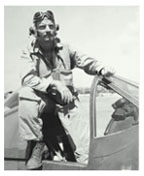
Dick
Nalle was a Marine Corps pilot who served mostly in the Pacific.
"My entire combat role was bombing and strafing Japanese-occupied
islands that had been bypassed. . . . I felt that I had relatively
soft war duty on •Dorothy Lamour' type atolls. I was fortunate."
He later worked at the Naval Air Test Center, testing Navy
pilots.
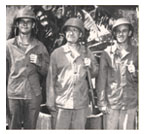
Mac Asbill
(left), who died in 1992, served in the Marine Corps, where
for more than two years he was an aide to General Holland
Smith (center). He accompanied Smith on amphibious landings
throughout the Pacific from Tarawa to Iwo Jima. Asbill earned
the Bronze Star and was honorably discharged as a captain.

Jack
Stutesman began the war as a commissioned second lieutenant
in the Army, serving the 88th Infantry Division as battery
officer. Late in 1943 he was named aide to the division's
artillery general. Though sad to leave his unit, he was grateful
for his life; the officer who replaced him was killed in Italy
Stutesman's
division landed in Naples in 1944. "On the night before the
great, successful attack toward Rome — that unforgettable
May 11, 1944 — I sat with a French officer, a friend of my
father. . . . He broke a loaf of bread and gave me half, saying,
•I do not know where my son is tonight, and your father does
not know where his son is. So tonight, we will be father and
son.' He was killed 10 days later."
For his
efforts in Italy, Stutesman received the Croix de Guerre and
a Bronze Star.
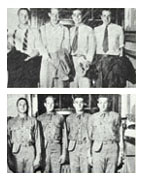
Pete
Priester, Jack Ormond, Buzz Seibels, and Clancy Stanard, along
with 13 other Princetonians, reported together to Chapel Hill
for Navy preflight training. The 17 Tigers then were sent
to Minneapolis to train as Marine pilots. Priester, who died
in 1973, flew mainly in the Solomon Islands, where his most
important and most dangerous mission was neutralizing a Japanese
stronghold in Rabau (and where he was narrowly saved from
enemy fighters by an Australian). Ormond also flew in the
Solomons. Seibels served as an instructor at Corpus Christi
before shipping out to the Philippines. Stanard (who bunked
with former President George Bush in Minneapolis) was sent
to Japan, where he had a narrow escape, shown on page 21.

Jim Merritt
(father of former PAW editor Jim Merritt '66) served in the
Army Air Corps with the 15th Air Force in Foggia, Italy. On
its eighth mission, to a target outside Vienna, his plane
took three direct hits from German shells. The 10-man crew
parachuted out over Croatia, where all but one were rescued
by Yugoslav partisans. (The tail-gunner was captured by German
supporters.) Pursued by Germans, the men struck out on a 49-day,
200-mile march through enemy territory, finally reaching the
Italian-held port of Zadar, Croatia, on Thanksgiving Day.
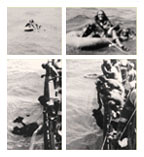
Marine
pilot Clancy Stanard was hit by anti-aircraft fire on one
of his more than 100 combat missions over heavily fortified
Japanese islands and bailed out over the Pacific. Fortunately,
Stanard was picked up by a minesweeper and returned to base.
He earned 17 Air Medals and six Distinguished Flying Crosses,
and later served as a pilot in the Korean War.

Of course,
it wasn't only the Class of 1942 who served in World War II.
Roy Mount '41, shown here on the yacht Sunbeam, was one of
a number of Princetonians who served with the Coast Guard,
patrolling for U-boats in the Atlantic. Mount explains: "In
1942 Nazi U-boats were sinking our ships right off the East
Coast. Yachtsmen members of the Cruising Club of America got
the idea that sailing yachts under shortened sail, making
no propeller noise, could detect submarines by means of underwater
listening devices. The Navy agreed to try it, and thus the
Sailboat Picket Patrol against U-boats was launched. Each
yacht was armed with two machine guns from World War I plus
a Springfield rifle — and, of course, a radio." For three
years, from 1942 to 1945, the flotilla of wooden boats patrolled
off Block Island and Montauk. Several Princetonians were in
the Coast Guard patrol — including John Ely '42, Laurence
Ely, Jr. '41, and Lester Wurfel '41, who skippered the Sunbeam
— and the entire operation of approximately 25 boats was commanded
by Bud Smith '29.
|